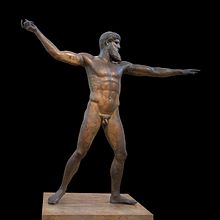Ancient aesthetics
Ancient aesthetics refers to the perception of beauty and form in the ancient world and the importance it was given in many ancient cultures.

Aesthetics Definition and History
[edit]Aesthetics is defined as the perception of art, design or beauty.[2] Aesthetics is derived from the Greek word "aisthetikos" [3] defined as a perception of the senses. In aesthetics, there is a process of individual analysis, perception and imagination.[4] Perception is defined as an individual's neurophysiological process of awareness and interpreting external stimuli.[5] Therefore, aesthetics is highly subjective and differs by individual.[6]
Aesthetics can also be used as a synonym to define taste or style[3] encapsulating artistic expression and activities such as rhetoric, tone, harmony, painting, composition art and music.[4] Aesthetics also encapsulates the look, feel, or sound of natural forms.[4] Aesthetics also encompasses the science of how an individual or a society perceives, feels, senses or knows an external stimuli.[5]
As a philosophy, aesthetics was developed in 18th century Germany by Emmanuel Kant.[7] However, Greek and Roman philosophers such as Aristotle[8] and Plato[9] engaged in the rhetorical debate of aesthetic perception and properties as a separate branch of philosophy in defining the parameters of art and beauty.[7] Ancient aesthetics shows the origin of aesthetic debate and influences modern aesthetic definitions.[4]
Ancient civilization
[edit]Ancient is defined as an early historical period that is identified by the oldest known civilizations.[10] Ancient history is the study of life and events during this period.[10]
Civilizations that fall under classification of ancient are: Ancient Greece (800 B.C. and 500 B.C.), the Incas (1438 A.D – 1532 A.D.), the Aztecs (1345 A.D – 1521 A.D), the Romans (550 B.C. – 465 B.C.), the Persians (550 B.C. – 465 B.C.), Chinese civilization (1600 B.C.E. – 1046 B.C.E.), Mayan civilization (2600 B.C. – 900 A.D.), Ancient Egypt (3100 B.C.E. – 2686 B.C.E.), Indus Valley civilization (3300 B.C. – 1900 B.C.) and Mesopotamia (3500 B.C. – 500 B.C.) [11]
Ancient Greek aesthetics
[edit]
Ancient or archaic Greece is the time period between 800 B.C. and 500 B.C.[13]
Beauty
[edit]Beauty in ancient Greece (800 – 300 B.C.E.) was referred to as κάλλος. The history of ancient Greek aesthetics spans centuries. Philosophical theories of beauty through this era are proportion, functionality and form.[7]
Greeks Gods
[edit]Influence of beauty was derived from the gods.[7] who took a divine human form and inspired their perception of beauty. Temples were created to worship gods, contained their lifelike images.[14]
Form
[edit]Ancient Greeks focused on the aesthetic form of the ideal human body.[14] captured through the art.[15] Sculptures were initially inspired by the monumental art of the Ancient Egyptians.[14] Sculptures were considered at their peak of aesthetics when the human form was captured in a unique way and emphasized a divine or godlike quality. Proportion, poise and perfection of the human form were the artistic and aesthetic ideals.[16] Stone and bronze monuments are iconic of this civilization.[16]
Ancient Egyptian aesthetics
[edit]
Beauty
[edit]Ancient Egyptians regarded physical beauty of the utmost importance and performed rituals to enhance their appearance.[18] Recovered artifacts support ancient Egyptian beauty ideals[19] including makeup, copper and silver handheld mirrors, and combs. Makeup was created using siltstones palettes to grind minerals such as green malachite or kohl.[19] Human hair was used to create extensions and wigs.[19] Jewelry enhanced beauty such as a string of beads and carnelian pendants in the shape of poppy heads.[19]
The afterlife and tombs
[edit]The Ancient Egyptians believed in an afterlife. Tombs were created for the dead and decorated with the highest form of their aesthetic principles.[20] Mummy masks and coffins emphasized painted eyes lined with dramatic black outlines.[19]
References
[edit]- ^ Sanzio, Raphael (November 15, 2018). "Crooped of The "School of Athens"". Wikipedia Commons.
- ^ Shelley, James (2017), Zalta, Edward N. (ed.), "The Concept of the Aesthetic", The Stanford Encyclopedia of Philosophy (Winter 2017 ed.), Metaphysics Research Lab, Stanford University, retrieved 2018-11-15
- ^ a b "What is Aesthetics?". The Interaction Design Foundation. Retrieved 2018-11-15.
- ^ a b c d "Greek and Roman Aesthetics – Classics – Oxford Bibliographies – obo". Retrieved 2018-11-15.
- ^ a b "perception | Definition of perception in English by Oxford Dictionaries". Oxford Dictionaries | English. Archived from the original on September 25, 2016. Retrieved 2018-11-15.
- ^ Faucault, Michael (November 10, 2018). "Aesthetics, Methods and Epistemology" (PDF). monoskop.
- ^ a b c d Celkyte, Aiste. "Ancient Aesthetics". Internet Encyclopedia of Philosophy. Retrieved October 20, 2018.
- ^ Sartwell, Crispin (2017), Zalta, Edward N. (ed.), "Beauty", The Stanford Encyclopedia of Philosophy (Winter 2017 ed.), Metaphysics Research Lab, Stanford University, retrieved 2018-11-15
- ^ Leszl, Walter G. (2006-10-01). "Plato's attitude to poetry and the fine arts, and the origins of aesthetics". Études platoniciennes (3): 245–336. doi:10.4000/etudesplatoniciennes.997. ISSN 2275-1785.
- ^ a b "Definition of ANCIENT". www.merriam-webster.com. Retrieved 2018-11-14.
- ^ "List of ancient civilizations". Encyclopedia Britannica. Retrieved 2018-11-12.
- ^ "User:Jebulon – Wikimedia Commons". commons.wikimedia.org. Retrieved 2018-11-15.
- ^ "Ancient Greece". HISTORY. Retrieved 2018-11-14.
- ^ a b c "How Art Made the World . Episodes . More Human than Human . Ancient Greece and the Naked Body | PBS". www.pbs.org. Retrieved 2018-11-12.
- ^ "How Art Made the World . Episodes . More Human than Human . Ancient Greece and the Naked Body | PBS". www.pbs.org. Retrieved 2018-11-12.
- ^ a b "Ancient Greek Sculpture". World History Encyclopedia. Retrieved 2018-11-12.
- ^ "User:Estere13 – Wikimedia Commons". commons.wikimedia.org. Retrieved 2018-11-15.
- ^ "BBC – History: Egyptians". Retrieved 2018-11-12.
- ^ a b c d e Sooke, Alastair. "How ancient Egypt shaped our idea of beauty". Retrieved 2018-11-12.
- ^ "How Art Made the World . Episodes . More Human than Human . Egyptian Need for Order | PBS". www.pbs.org. Retrieved 2018-11-12.
